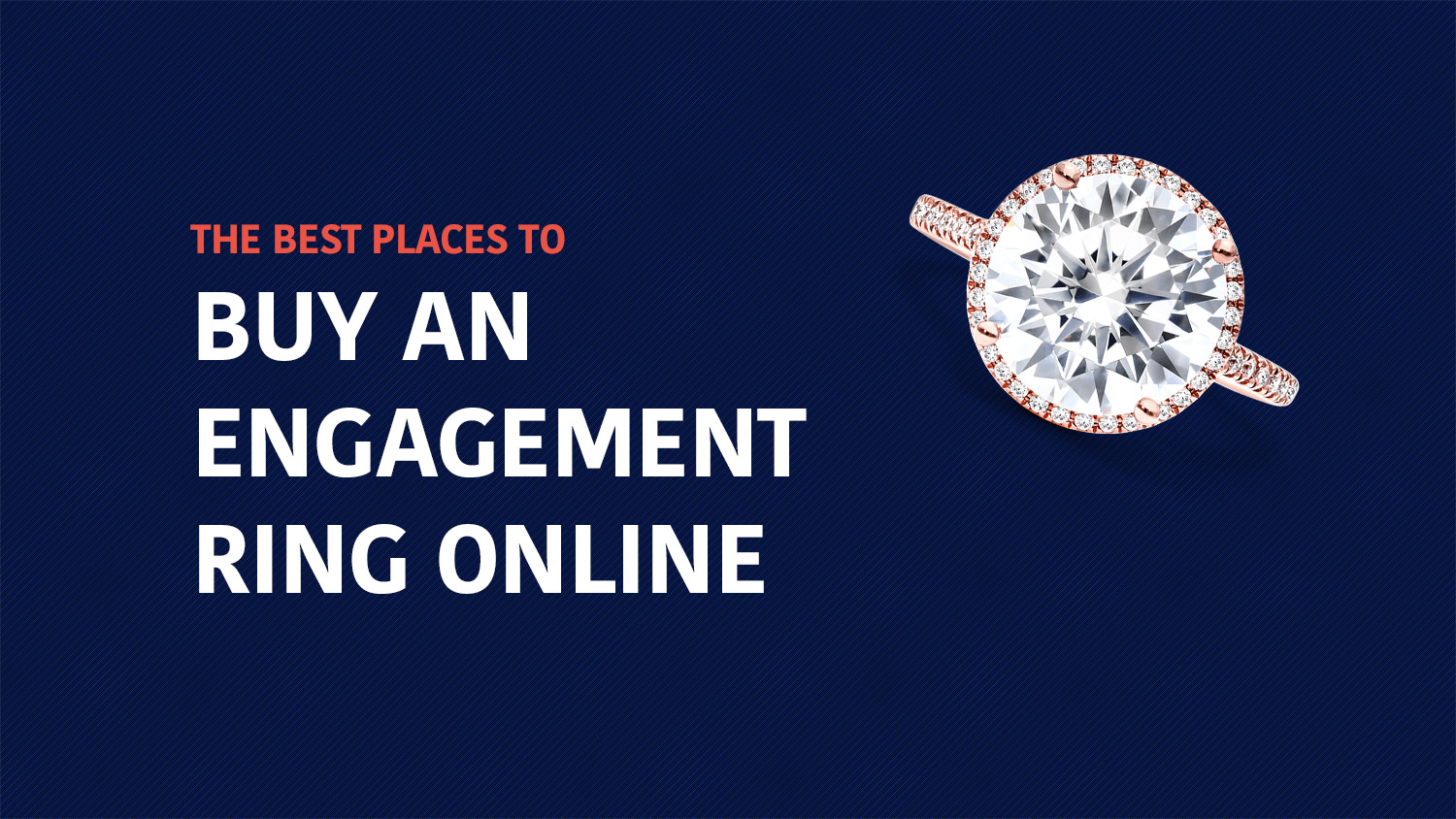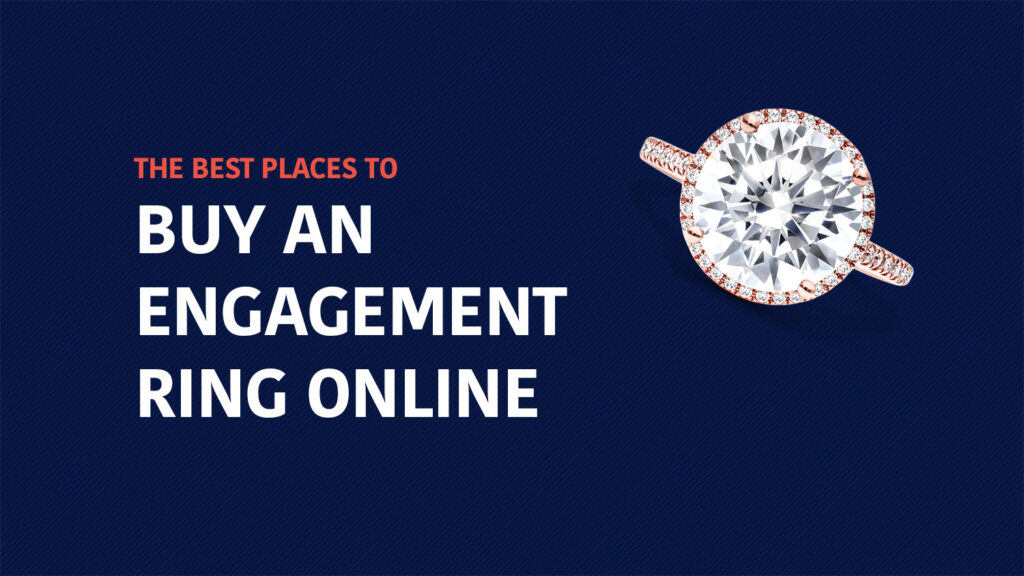 It’s no surprise that diamond engagement rings are one of the most marked-up products you can buy.
It’s no surprise that diamond engagement rings are one of the most marked-up products you can buy.
The good news is you can buy a beautiful, authentic diamond engagement ring for a fraction of what you’ll pay at a national jeweler…if you know where to look.
Best places to buy engagement rings
- Best place to buy diamonds: James Allen
- Best customer service : Blue Nile
- Best for custom jewelry: CustomMade
James Allen
Boasting an inventory of thousands of diamonds for sale, it’s hard not to find what you want from James Allen.
James Allen is one of the big online jewelry retailers, famous for its low prices. With thousands of high-quality, conflict-free diamonds to choose from, easy customization options, and lifetime warranty, James Allen might as well be considered an engagement ring king.
- Larger selection
- Easy customization for price and quality
- Lower prices than brick and mortar
- Time-consuming selection process
- Less expert guidance
With James Allen, you can purchase loose diamonds in 10 different shapes. You can shop for natural and lab-grown diamonds in 10 colors. Or you can custom design your own ring if you don’t find what you want on the site.
On top of its diverse offerings, James Allen is often more affordable than other accessible luxury online jewelers in its class. And finally, James Allen ensures that its diamonds are conflict-free.
» Shop now on James Allen or read our full James Allen review
Blue Nile
Free shipping, free returns, cleaning and servicing, financing availability, a lifetime manufacturer warranty, and the potential to match a competitor’s price are just a few of the benefits that the ”OG” of online jewelry retail, Blue Nile, offers.
Blue Nile is hands-down one of the most popular online jewelers — and it has been for quite some time. With discount prices and a large inventory of loose diamonds, Blue Nile offers simplicity in narrowing down your search for the perfect match to your occasion.
- Enormous selection to choose from
- Easily customizable options
- All diamonds are conflict free
- Not all diamonds offer a 360-degree view
- Can be time-consuming given selection
Blue Nile is not only concerned with getting customers but also keeping them. Its longevity — Blue Nile was founded in 1999 — is earned.
» MORE: Shop now on Blue Nile or read our full Blue Nile review
CustomMade
 Founded in 2009, the aptly-named online custom jeweler CustomMade makes pieces from conception to fruition using a four-part process. It appears to be working — the company says that it’s helped more than 8,000 couples get engaged.
Founded in 2009, the aptly-named online custom jeweler CustomMade makes pieces from conception to fruition using a four-part process. It appears to be working — the company says that it’s helped more than 8,000 couples get engaged.
Below is CustomMade’s process for clients who want to get a piece designed. Most of the rings start at $1,000.
- Talk About It – Discuss design ideas, options, and budget with your jewelry consultant — your guide to the custom experience.
- Get It Designed – See sketches and concept art designed just for you by CustomMade’s jewelry artists.
- See It Come to Life – Visualize your piece with high-resolution 3D renderings, and adjust every detail until it’s perfect.
- Treasure It – Receive your custom piece, with the assurance it’s been made to wear and last a lifetime.
» MORE: Shop CustomMade now
The competition
Clean Origin
 Founded in 2017, Clean Origin only uses lab-grown diamonds, advocating that they are more environmentally friendly and sustainable than traditional, mined diamonds. The company’s CEO is Alexander Weindling, a third-generation diamond merchant.
Founded in 2017, Clean Origin only uses lab-grown diamonds, advocating that they are more environmentally friendly and sustainable than traditional, mined diamonds. The company’s CEO is Alexander Weindling, a third-generation diamond merchant.
Clean Origin’s mission is to introduce the world to 100% conflict-free diamonds. It offers 100-day returns, free sizing, and all of its lab-grown diamonds are certified. You can schedule a virtual appointment on the website, or those who don’t want to order online can visit Clean Origin’s showroom in a Dallas suburb.
SevenJune Jewelry
 If you want a more personal touch when purchasing diamonds, consider using a private jeweler such as SevenJune Jewelry.
If you want a more personal touch when purchasing diamonds, consider using a private jeweler such as SevenJune Jewelry.
“As a private jeweler, I am not beholden to any one supplier or pressed to sell an item just because I have to make a quota, or because an item is in stock, the way a retail jeweler is,” said Zenobia Morrow, owner and designer at SevenJune Jewelry. “I really have a full range in the market to source the right item for that particular customer’s needs. From a pricing perspective, my overhead is low and I am able to extend savings to my customers.”
Morrow’s style aesthetic is feminine and clean. The Georgia native studied gemology at the Gemological Institute of America and was once a managing director of a New York City diamond house. She uses natural diamonds.
Ritani
 With its easy-to-navigate website and extensive natural and lab-grown diamond selection, Ritani is one to watch in the competitive, cost-conscious online jewelry space.
With its easy-to-navigate website and extensive natural and lab-grown diamond selection, Ritani is one to watch in the competitive, cost-conscious online jewelry space.
If an online competitor’s diamond is less expensive, Ritani will try to find a similar diamond at a lower price. The White Plains, New York jeweler has a “transparent diamond pricing tool” that breaks down the cost of every diamond from the wholesaler, the operational costs (shipping, packaging, and process), and the final margin earned by Ritani on every sale, according to its website.
Ritani’s motto? “We’ve made getting to know your diamond easier than getting to know your in-laws.”
How to save money on diamonds
Don’t buy from a chain jeweler
If you want to save money on an engagement ring or wedding rings, skip the chain jeweler.
Sadly, most people go straight for the mall jeweler without considering the alternatives. Before I knew better, I did, too.
It’s easy to understand why: Major jewelers like Kay, Zales, Jared, Tiffany’s, etc. spend millions on advertising, are easily accessible nationwide, and give most diamond-buyers peace of mind that they’re dealing with a reputable company. I would venture to guess that when buying diamonds, many people would rather overpay than risk spending hundreds or thousands on a gem that is not the indicated quality or isn’t even genuine.
There’s nothing wrong with shopping at these chain jewelers to get a sense of what kind of ring you want, but the simple fact is that these stores mark up diamonds to double their cost…or more.
If you do have your heart set on a specific engagement ring from one of these stores, always try negotiating. Early in my ring-buying experience I had a chain jeweler manager slashing the price of one ring by hundreds of dollars before I even asked. On the flip side, some of the higher-end jewelers with brands to protect will absolutely not negotiate their prices. But you never know until you ask.
If not chain stores, then where?
If your goal is to get the absolute best deal on your ring, and you don’t live near a diamond district, you should probably buy your engagement ring from a reputable online jeweler.
During my ring-buying experience, I was blown away by online diamond stores like James Allen and Blue Nile.
The sites let you search through over 25,000 diamonds to find those in your price, size, and quality specifications, and you can match your chosen gem with dozens of setting options. Prices seem to be nearly half of comparable rings in brick-and-mortar jewelers, and they also offer free shipping and free returns.
How much can you save?
Quite a bit. We found a simple 4mm platinum comfort fit men’s wedding band for $780 on James Allen compared to $1,450 at a local Jared the Galleria of Jewelry store — nearly half the price! The savings on diamond engagement rings can be even greater.
eBay is also rife with some incredible diamond deals, although buying through an online auction is a bit riskier than through a reputable online dealer. If you decide to buy an engagement ring on eBay, make sure you’re well-versed in diamond values and eBay transactions. Only purchase a ring if the seller agrees to use an escrow account for payment and allows you to take the ring to a jeweler for appraisal once you receive it.
Local jewelers vs online jewelers
If buying a diamond online isn’t for you, check out your local jewelers. Although rings at these stores will be significantly more expensive than rings online, you’ll get more bang for your buck than at chain jewelers, as well as better craftsmanship and, most likely, a ring that is more unique.
Although I purchased my fiancée’s engagement ring at a chain jeweler after being unable to find the style ring I wanted online, we’re having a local jeweler design a new ring for the diamond after my fiancée discovered the ring’s setting was too high and she was banging it around. We get top-notch service from this jeweler, and his custom-designed setting will end up costing less than many of the generic settings available in the chain stores.
Should I buy a diamond from a wholesaler?
For the brave, the absolute cheapest way to buy a diamond engagement ring is to buy a loose stone from a diamond wholesaler. To do this, you’ll have to live in or travel to a major city like New York and visit the diamond district in person. You’ll need to know what you’re doing, because these dealers are used to dealing with professional jewelers, and may try to take advantage of a naive buyer.
That said, if you negotiate correctly you can get your rock at wholesale prices and then have a jeweler design a setting. One final caution: Most of these dealers only accept cold hard cash. I had a colleague at SmartMoney magazine buy his fiancée’s diamond this way and I recall him recounting how strange it was to walk through Midtown Manhattan with thousands of dollars in his pocket.
Remember: It doesn’t have to be a diamond!
Although this post is mostly about saving money on a diamond engagement ring, there is no rule saying that an engagement ring has to be a diamond. It’s just a tradition that has been successfully propagated by a powerful diamond lobby keen on profit. You can find beautiful engagement rings that can show off your originality for a fraction of the cost.
There are plenty of non-diamond engagement ring ideas that can carry just as much meaning. Alternatives include lab-grown diamonds, knot rings, engraved bands and even matching tattoos. Other gemstones like rubies or sapphires are also popular options.
Summary
To buy a beautiful diamond without overpaying, the best places to buy engagement rings are online. James Allen and Blue Nile are two of the largest, most trusted online jewelers in the diamond business — you can’t go wrong with either.
Wherever you end up buying, the most important thing is to make sure you’re not bringing financial stress into your new marriage. Don’t spend more than you can afford.




